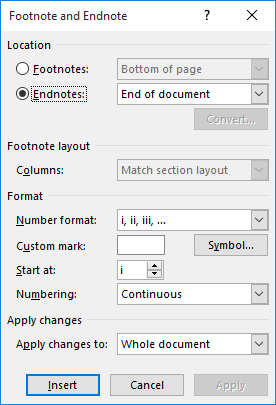Please Note: This article is written for users of the following Microsoft Word versions: 2007, 2010, 2013, 2016, 2019, 2021, and Word in Microsoft 365. If you are using an earlier version (Word 2003 or earlier), this tip may not work for you. For a version of this tip written specifically for earlier versions of Word, click here: Default Numbering Format for Endnotes.
Written by Allen Wyatt (last updated June 3, 2023)
This tip applies to Word 2007, 2010, 2013, 2016, 2019, 2021, and Word in Microsoft 365
Ken wonders if it is possible to change the default numbering format for endnotes from lowercase Roman numerals (i, ii, etc.) to uppercase Roman numerals (I, II, etc.). While this can be done manually in the Insert Endnote dialog box, that takes several steps and a change to the default would be much easier and faster.
It is possible to change the default, but the way you do it is to change the template on which new documents are based. In most cases, this means changing the Normal template because most new documents are based, automatically, on settings stored in the Normal template. (In other words, changing the template is how you change many of Word's defaults—including endnote numbering styles.)
In order to make a change to the Normal template you need to load it directly. The location of the Normal template will vary from system to system, but you can use the Windows search feature to locate it. (Just search for Normal.dotx, Normal.dotm, or some variation of these names.) Load the template directly into Word and then follow these steps:

Figure 1. The Footnote and Endnote dialog box.
The next time you create a document based on that template, the endnote reference numbers will be formatted as Roman numerals (assuming you selected a Roman numeral format in step 3). This won't affect any existing documents, only new ones.
WordTips is your source for cost-effective Microsoft Word training. (Microsoft Word is the most popular word processing software in the world.) This tip (5936) applies to Microsoft Word 2007, 2010, 2013, 2016, 2019, 2021, and Word in Microsoft 365. You can find a version of this tip for the older menu interface of Word here: Default Numbering Format for Endnotes.

Do More in Less Time! An easy-to-understand guide to the more advanced features available in the Microsoft 365 version of Word. Enhance the quality of your documents and boost productivity in any field with this in-depth resource. Complete your Word-related tasks more efficiently as you unlock lesser-known tools and learn to quickly access the features you need. Check out Microsoft 365 Word For Professionals For Dummies today!
Adding endnotes in a document is easy in Word. If you want to create multiple references to a single endnote, you can do ...
Discover MoreEndnotes are often used in technical and scholarly documents. You can control exactly where the endnotes appear in your ...
Discover MoreWord is flexible on how it numbers your endnotes. This tip shows how easy it is to make the changes to the numbering system.
Discover MoreFREE SERVICE: Get tips like this every week in WordTips, a free productivity newsletter. Enter your address and click "Subscribe."
There are currently no comments for this tip. (Be the first to leave your comment—just use the simple form above!)
Got a version of Word that uses the ribbon interface (Word 2007 or later)? This site is for you! If you use an earlier version of Word, visit our WordTips site focusing on the menu interface.
Visit the WordTips channel on YouTube
FREE SERVICE: Get tips like this every week in WordTips, a free productivity newsletter. Enter your address and click "Subscribe."
Copyright © 2026 Sharon Parq Associates, Inc.
Comments